Krupp Protze
 Germany (1934-41) - Utility 6x4 lorry - 7,000 built
Germany (1934-41) - Utility 6x4 lorry - 7,000 built
Another axis trucks of WW2 that was quite famous, was the sole light 6x4 lorry of the Wehrmacht, the 1934 Krupp Protze. An artillery tractor produced between until 1941 to 7,000 vehiclzq of all versions, so it was heavily used in World War II. Among those versions, the base vehicles was classed by the waffenamt ass either the Kfz 69 of Kfz 70. The vehicle was promently used on the Eastern Front, North Africa, France and Sicily but its high consumption compared to the frugal Opel Blitz 1.5 t truck which superseded it, had it converted soon for other roles, notably weapons carrier. The chassis was also used for the rare 6x6
Sd.Kfz.247 ausf A armoured car (only 10 made).
Design development 1933-34
 Early troop carrier vehicle in trials, showing the utility of the upper "free axle" on rough terrain.
Early troop carrier vehicle in trials, showing the utility of the upper "free axle" on rough terrain.
The name itself and concept wen back to WWI. "Protze" just means munitions limber and the name was already presented for the "Kraftprotze", Krupp's "powered limber" concept of 1918, a lightly-armoured vehicle usable as gun tug or limber tower as part of the development of the
LK-II development. Placed in the May 1918 submission, armed with a single MG 08 machine gun it was a supply tank, but by the Summer of 1918, Krupp proposed an upgunned Kraftprotze with an MG 08/15 and 5.7 cm Maxim-Nordenfelt cannon. But OHL preferred Joseph Vollmer's Leichter Kampfwagen III. The name and projects were buried, as the concept of armoured supply tank.
Needless to say with the Treaty of Versailles Krupp was forced to cease of tanks developments as well as weaponry researches, with excetion of those under entente supervision. Krupp focus on production of special steels, locomotives, farm machinery, public works vehicles as well as engines notably for trucks and its "Truck Factory Department" opened up in 1919 with as first model the "5-ton with 75 HP 4-cylinder Otto Engine" the next year.
In 1924, Krupp extended its range to 1.5, 2.5 and 3-ton high-speed trucks and by 1925 presented a modified 5-ton truck and low chassis buses in 1928. Its commercial range varied by chassis heights (H, M, N), engines (petrol, diesel, wood gas) and/or load capacities ( 1.5, 2, 2.5, 3, 3.5, 4, 5, 5.5, 6.5 tons) and the company developed more modern truck engines, using high-performance carburetors or better air-cooling for its diesel engines. In 1937 Krupp delivered 4.300, vehicles while the company had 2.685 employees.
Well before that in 1929, thanks to contacts, Krupp was informed of the growing rise of militarism in circles, and the possible takeover of the nazi party in elections, which never hid their own stance on the army. Krupp this started development on private venture of a light three-axle, cross-country chassis for military uses. It needed to have both high ground clearance and reduced weight for better traction on all grounds, so the company provided a new super-compact four-cylinder M302 boxer engine. First trial vehicles Krupp L2 H43, used a conventional high engine bonnet and the engine compartment was tailored to test also a diesel engine on the LD2 H43. The Krupp L2 H43 sloping engine bonnet became a trademark for the model thanks to the compact boxer engine, no air cooling so no radiator needed.
The Reichswehr took interest as expected of the vehicle in the midst of a wave of development of medium to heavy six-wheeled cross-country chassis from 1925 onwards by various companies, and they seemed underpowered or just too heavy for off-road use. By 1933, the Krupp L2 H43 was further refined and now closed in a possible serial production state. So by 1934, the waffenamt approved a first pre-serie but shifting priorities of the Reichswehr meant the Krupp L2 H43 was now presented to a platform lorry/motorised limber, no longer a six-seated passenger car as tested previously.
By 1935, the Krupp L2 H43 became the de facto tractor for light guns, or "Protzkraftwagen" given the number Kfz.69. However soon many would nicknamed it the "Krupp-Protze" instead of using the L2 H43 factory designation, and it stuck. The next iteration was the L2 H143 introduced in 1936. It had a stronger M304 engine and the distances between the two rear axles was greater for better stability and traction, plus broadened bumpers and many other details. Work still went on the chassis, leading in 1949 to the Krupp L2 H243 with a 70 HP engine, all-wheel drive but it was never reached production. The standard H43/143 Protze indeed was successful enough and Krupp concentrated on mass producing the two main version, troop carrier and artillery prime mover, so that in the end in 1942, some 7000 were delivered until production ceased as the model was seen as obsolete and the engine fuel-hungry, now a rare commodity.
Its replacement arrived in 1941, it was the new all-wheel 1.5 ton lorry Schell-Plan chassis with better performance characteristics and easier manufacturing, chief of which was the
Opel Blitz that succeeded it.
Design
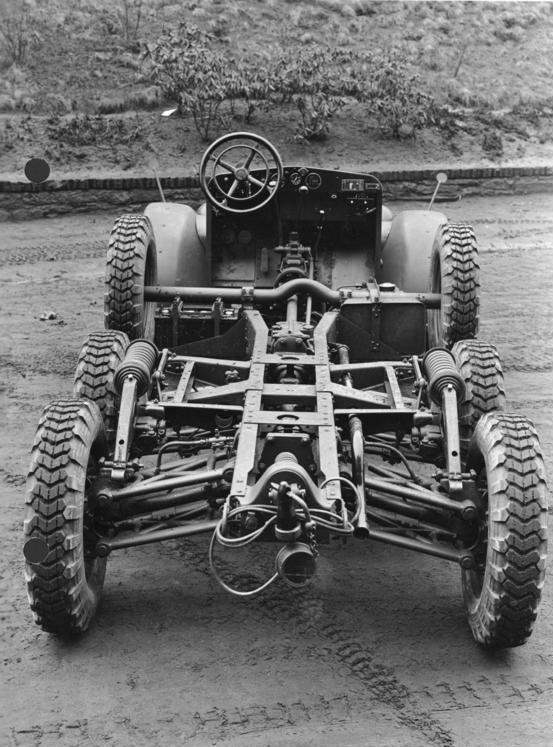 Krupp 15-Tonner Krupp-Protze chassis rear
Krupp 15-Tonner Krupp-Protze chassis rear
Krupp' designation reflected the caracteristics of its truck: L2 H143 means in order: L for Lastwagen (truck), 2 as load capacity in tonnes, H as it was a light frame, 1 for the first modification (from 43 to 143, 243, etc), 4 the number of engine cylinders and 3 for three axles.
Chassis and base design
 Krupp 15-Tonner Krupp Protze
Krupp 15-Tonner Krupp Protze
The Geländewagen (all-terrain vehicle) Krupp Protze L2 H43 was a six-wheeled 6x4 chassis in the light category. This truck/artillery tractor whioch started production in 1934 and 1936, then from 1937-1941 as the L2 H143, had a very simple frame chassis, with a central, narrow frame ending in a "V" encompassing the supports for the cab, engine and forward axle. There were four-stud tubular types with torsion bars, anchored on the central chassis ladder, supporting each rear roadwheels, not directional. Their upwards and downwards movement were cushioned by a vacuum and coil cylinder anchored on struts above.
The full vehicle was compact, 5.10m in lenght overall for 1.96 m in width and 1.93 meters high on top of the windshield. It was a low silhouette, difficult target to spot and hit. Empty weight, now fully equipped, jumped to 2,450 kg and for one variant, 2,825 kg (telecommunications car). The maximum weight the chassis can take was 3,600 kg up to 3,750 kg for the H143. Towing capacity of 1,000 kg only authorized light ordnance like the PAK 36 or short barrel howitzer. Ground clearance was 225 mm, and wading depth 600 mm. It was not amphibious but could cross any bridge in existence and most small rivers.
In addition to the forward directional axle, suspended by leaf springs under mud covers, just behind the cabin was located a free-floating axles with two spare wheels which acted as chassis support on heavily cratered terrain, this made an occasion eight-wheeled vehicles. The free axle was located 50 cm above the others, with built-in lodgings in the body and it was wider than the other three.
The utility flatbed was built above the ladder chassis, and relatively short. In tractor configuration (Kfz.69) it had just enough space for four mean seated in vis a vis, when acting as troop carrier. There was enough space behind to install a spare wheel. The Troop carrier (Kfz.70) had a larger two bench rear compartment for six men, and extra storage bins on the sides. The body was reconfigurated later for the Kfz 81 leichter Flakkraftwagen, or completely modified for the schwerer geländegängiger Personenkraftwagen (staff-car) Kfz.21 with two doors, six seats, or the Funkkraftwagen Kfz.19 (four doors, storage bin aft).
The forward cabin was fully open, with two seats located in between the free spare axle, no doors for easier access, less weight, and foldable two-parts windshield. A tarpaulin could be then extended from the latter to the rear. Troop versions had in addition frames for it. The vehicle was unarmed, except for a pivot-mounted MG.34 in the rear flatbed. Of course some variants carried various ordnances (see versions). Some variants carried up to three spare wheels on their back bonnet...
Mobility
 M304 Engine Krupp
M304 Engine Krupp
The weigh was 2.5 tons only with only the engine hood bonnet and rear paneling. It was powered by a 55 hp (L2 H43) or 60 hp (L2 H143) Krupp Boxer 3.3 litre engine M 304 petrol. This enabled a range of 450 kilometers, payload of 1 ton, top speed around 40 kph. The L2.H143 (1937) was longer of just 15 cm (6 inches), and its 60 hp at 2500 rpm (3308 cu.cent. capacity) engine gave it better performances. It was relatively agile, woth a turning circle of 14.5 m. Contrary to the others it also presented a longer, proper front bumper. None had a winch in basic version.
The Krupp engine was connected to a four-speed manual transmission (ZF-Aphon) with countershaft and two locking differentials to both rear axles speed transfer box for four normal, eight total speeds with differential. Suspension comprised a front directional rigid axle with leaf springs and rear independent axles with horizontal coil. The eight tyres were all of the 7.50 x 17 type. Electric power was provided by a Bosch battery, 12 volts 75 Ah. It could climb 60% sloped, and gap most trenches thanks to its four axles.
The Krupp Protze presented in 1933 excellent performance both on and off road, and was suerly the lightest, most mobile military 6x4 in Europe at the time. An alternative with less drag compared to half tracks. With a top speed of 70 km/h (43 mph) on road, light, it was down to 60 kph with the ususal 1,150 kg (2,540 lb) payload. Fuel capacity was 110 L (24 imp gallons or 29 US gallons) for 450 km (280 miles) on road for the range. Good enough for Europe, it was not impressive when dealing with very muddy terrain over long distances and heavy loads on the eastern front. The vehicle was a gas-guzzler, especially compared to the Opel Blitz (twice as much, 24 vs. 16 liters/100 km).
Production versions 1935-41
 leichter Flakkraftwagen Kfz.81 mit Fahrgestell des l.gl.Lkw.
leichter Flakkraftwagen Kfz.81 mit Fahrgestell des l.gl.Lkw.
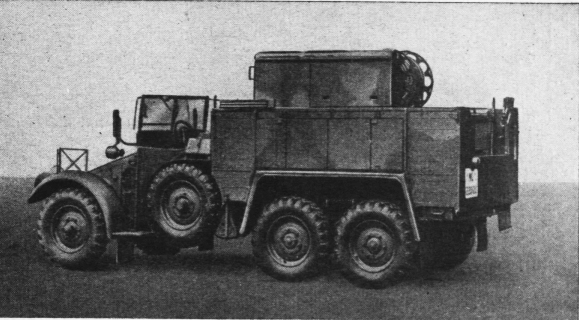 Leichter Scheinwerferkraftwagen I Kfz.83 mit Fahrgestell des l.gl.Lkw.
Leichter Scheinwerferkraftwagen I Kfz.83 mit Fahrgestell des l.gl.Lkw.
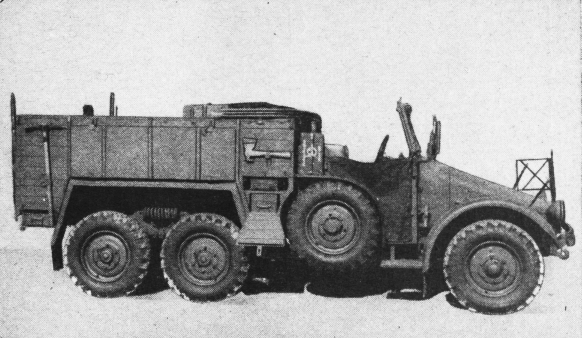 leichter Scheinwerferkraftwagen II Kfz.83 mit Fahrgestell des l.gl.Lkw
leichter Scheinwerferkraftwagen II Kfz.83 mit Fahrgestell des l.gl.Lkw
 Mannschaftskraftwagen Kfz.70 mit Fahrgestell des l.gl.Lkw
Mannschaftskraftwagen Kfz.70 mit Fahrgestell des l.gl.Lkw
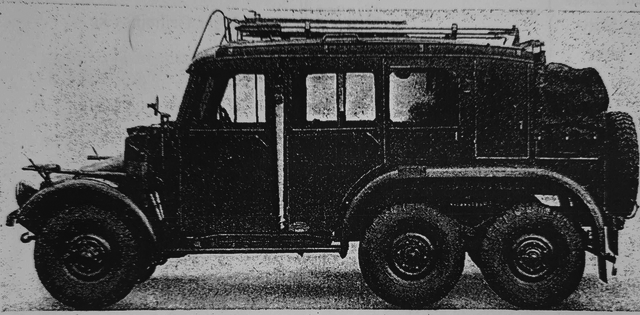 Fernsprechbetriebskraftwagen Kfz.19 mit Fahrgestell des le.gl.Lkw.
Fernsprechbetriebskraftwagen Kfz.19 mit Fahrgestell des le.gl.Lkw.
 1.5 Tonner Krupp-Protze bonnet
1.5 Tonner Krupp-Protze bonnet
In 1939, Nazi Party requirements limited production to 3-tonne and 6.5-ton civilian trucks for Krupp and other manufacturers for rationalization of efforts and focusin on military production. In 1940, Krupp was forced to limit itself to the 12-ton heavy half-track Sonderkraftfahrzeug 8 (
Sd.Kfz 8) (DB9) and the Krupp Protze, albeit it was scheduled to end in 1941. By that time, aside truck engines, the company ceased manufacturing the Protze L2 H43 for the H143 terminated development of the H243 and 343. In 1942 the Krupp Protze was delivered at 200 a month when order came to terminate the production of a vehicle now considered underpowered and obsolete. The company focused on the SdKfz 8, with 3.403 employees but air raids on Essen from March 1943 cut down 70% of the facilities and subsequent production.
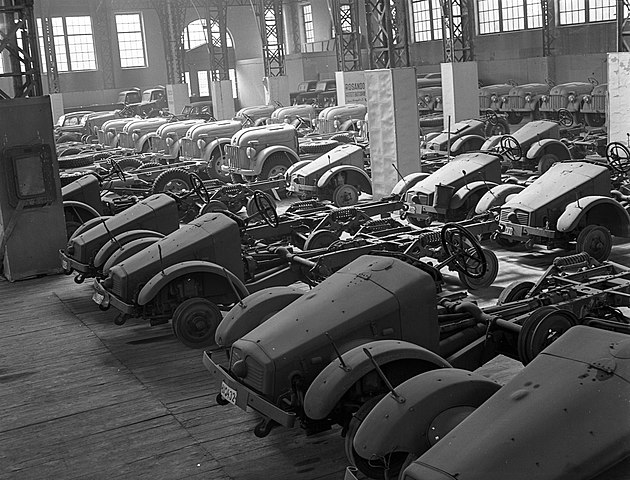 Hungarian-built Protze, Budapest
Hungarian-built Protze, Budapest
- Kfz.19 Funkwagen (Telephone truck)
- Kfz.21 Staff car
- Kfz.68 Radio mast carrier (Kfz. 68 Fu. Mast Kw. aud KP)*
- Kfz.69 Standard prime mover, 3.7 cm Pak 36 ATG.**
- Kfz.70 Standard personnel carrier (2 front, 10 seated on benches).
- Kfz.81 Ammo carrier, prime mover, 2 cm FlaK
- Kfz.83 Generator carrier, AA searchlight, towed***
- Sd.Kfz. 247 Ausf. A APC 6x6 (20 built 1937) by Daimler-Benz.
*Another Funkmastkraftwagen was based on a Mercedes G3a light truck chassis
**Carried 2 in front with 4 in a pair of forward and rear facing seats.
***60 cm Flak-Scheinwerfer 36 towing vehicle for the 60 cm Flak-Scheinwerfer 36 for Flakbatteries 2cm.
 Rare Pak 37 carrier variant with improvized armour.
Rare Pak 37 carrier variant with improvized armour.
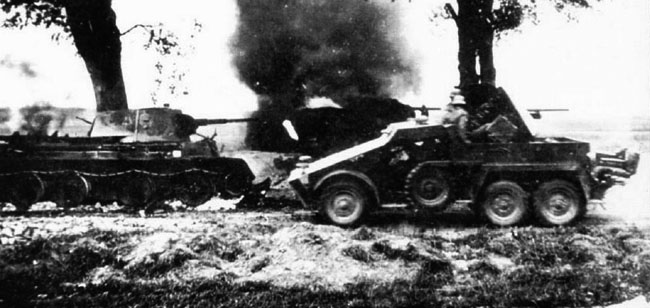 L2H143 Kfz.69 Armored 3.7cm Pak-36
L2H143 Kfz.69 Armored 3.7cm Pak-36
Official designations
Fernsprechbetriebskraftwagen (Kfz.19) mit Fahrgestell des l. gl. Lkw. (o), abbreviated Fsp. Betr. Kw. (Kfz. 19)
Funkkraftwagen (Kfz. 19) mit Fahrgestell des l. gl. Lkw. (o), abbreviated Fu. Kw. (Kfz. 19)
Schwerer geländegängiger Personenkraftwagen (6-sitzig) (Kfz. 21) mit Fahrgestell des l. gl. Lkw. (o) abbreviated s. gl. Pkw. (6-sitzig) (Kfz. 21)
Funkkraftwagen (Kfz. 61) mit Fahrgestell des l. gl. Lkw. (o) abbreviated Fu. Kw. (Kfz. 61)
Funkmastkraftwagen (Kfz. 68) mit Fahrgestell des l. gl. Lkw. (o), abbreviated Fu. Mast Kw. (Kfz. 68)
Protzkraftwagen (Kfz. 69) mit Fahrgestell des l. gl. Lkw. (o), abbreviated Protz Kw. (Kfz. 69)
Mannschaftskraftwagen (Kfz. 70) mit Fahrgestell des l. gl. Lkw. (o), abbreviated Mannsch. Kw. (Kfz. 70)
Leichter Flakkraftwagen (Kfz. 81) mit Fahrgestell des l. gl. Lkw. (o) abbreviated l. Fl. Kw. (Kfz. 81)
Leichter Scheinwerferkraftwagen I (Kfz. 83) mit Fahrgestell des l. gl. Lkw. (o) abbreviated l. Scheinw. Kw. I (Kfz. 83)
Leichter Scheinwerferkraftwagen II (Kfz. 83) mit Fahrgestell des l. gl. Lkw. (o), abbreviated l. Scheinw. Kw. II (Kfz. 83)
Schwerer geländegängiger gepanzerter Personenkraftwagen (6-Rad) (Sd. Kfz. 247) mit Fahrgestell des l. gl. Lkw. (o), abbreviated s. gl. gp. Pkw. (Sd. Kfz. 247)
Sub/rare variants
Fahrbarer Landebahn-Scheinwerfer mit Anhänger on chassis Krupp L2 H43 (ca. 1935) mobile landing stripe ilumination vehicle
Gruppenwagen with chassis Krupp L2 H143 (only prototypes)
Wilton-Fijenoord Pantserwagen resp. Panzerkraftwagen Krupp, holländisch (H43) (3 made, one for Ordnungspolizei)
Krupp-Polizei-Streifenwagen on chassis Krupp L2 H243 (1938, 1-2 made for exhibits and demonstrators). These experiemrntal vehicles a sloped armour, oe was presented at IAA in Berlin propelled by a 70 HP engine wth reversing drive gearbox based on the H243 chassis.
The Kruppe Protze in combat
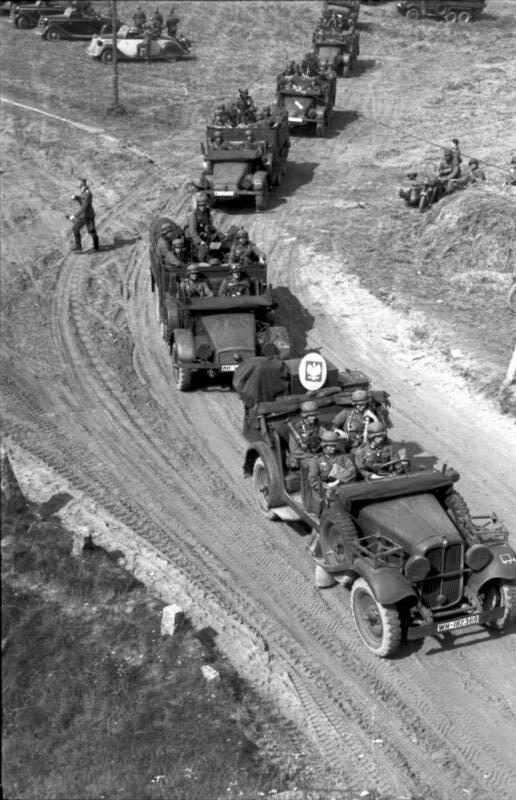 Krupp Protze in Poland
Krupp Protze in Poland
The vehicle became the organic Infanterie division's prime mover for anti-tank units. The Krupp L2 H43was the Mannschaftskraftwagen (personnel carrier) Kfz. 70 and the L2 H143 Protzkraftwagen (motorised limber) Kfz. 69 became standard in all motorised infantry units. They towed the 3.7 cm Pak for air defence, and the
7.5 cm le.IG.18 short barrel gun for infantry support.
The Luftfwaffe also adopted and operated the leichter Flakkraftwagen Kfz. 81 for towing the 2 cm Flak 30 and 38, variant in relatively short supply, but alsot eh Kfz.83 Generator carrier for an AA searchlight. They were used around airfields close to the frontline. In 1939/40 the last version delivered was an off-road six-seats cabrioletbased on the L2 H143 as staff car. The early version had a high engine bonnet which. Of course there were also radio versions which filled the Motorized unfantry units as well.
The vehicle made its combat debut in Spain, as part of the Legion Condor.
Two armoured cars were made based on this chassis: The Sd.Kfz.247 Ausf A was produced in very small numbers for the Wehrmacht and there was a conversion of a tank hunter carrying a PAK-36 3.7 cm antitank gun in the aft compartment, with the cabin protected by sloped armour. Photos exists, but production is unknown. Some authors pretent only one was ever made on the eastern front.
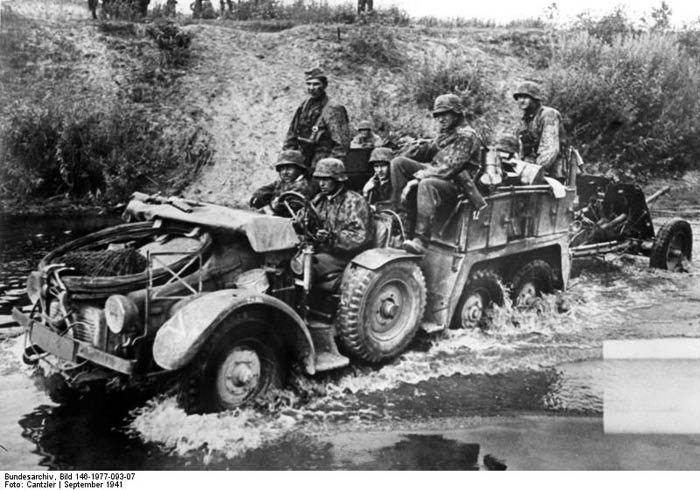 River crossing by a Krupp Protze
River crossing by a Krupp Protze
Globally the Krupp L2 H43/H143 or "krupp protze" proved successful, one of the best Wehrmacht vehicles in its payload class when WW2 broke out, having even better performance than the schwere Einheits-Pkw. However the whole technical base and its high fuel consumption halted production in 1942. The
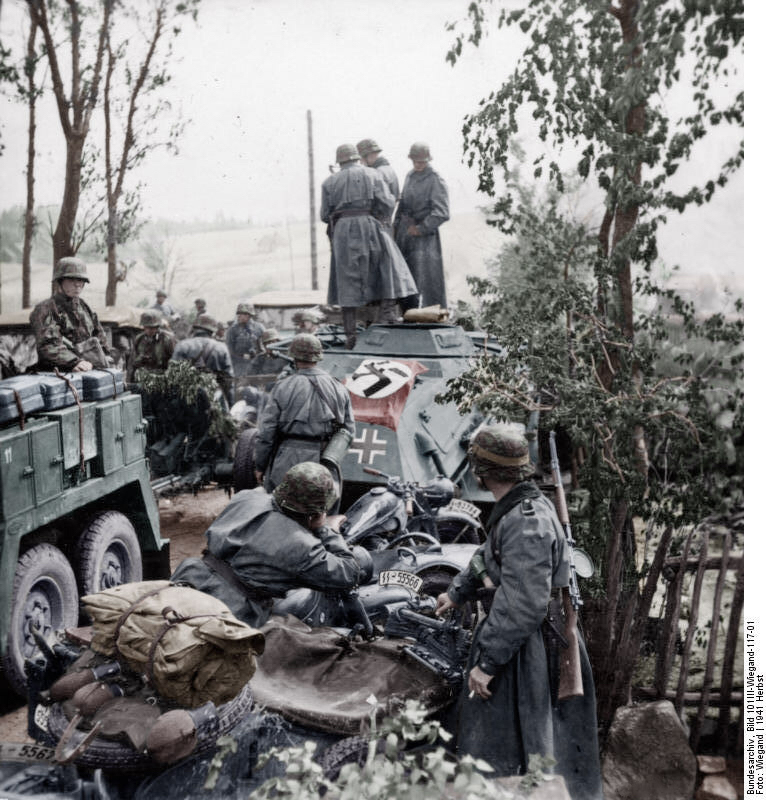 Bundesarchiv Russia motorisierte unit SS-Totenkopf Division, Krup Protze Recolored
Bundesarchiv Russia motorisierte unit SS-Totenkopf Division, Krup Protze Recolored
 Bundesarchiv Anschluss, sudetendeutscher Krupp Protze
Bundesarchiv Anschluss, sudetendeutscher Krupp Protze
Krupp-Protze specifications Kfz.69(1)/70(2) |
| Dimensions | 5.10 x 1.93 x 1.96m (16 ft 9 in x 6 ft 4 in x 6 ft 5 in) |
| Wheelbase H43/H143 | 2470+860/2445+910 |
| Total weight, battle ready | 2,600 kg (5,700 lb) |
| Crew | 1+5 passengers, light towed gun(1) or 2+10(2) |
| Propulsion (1)(2) | Krupp Boxer 3.3L 6-cyl. M302/M304 53/60 hp |
| Top speed | 70 km/h (43 mph) |
| Payload | 1,150 kg (2,540 lb) |
| Transmission | Unknown |
| Suspension | Torsion Bars |
| Maximum range (on/off road) | 110 L (24 imp gal; 29 US gal), 450 km (280 mi) on road |
| Armament | None, see notes |
| Production | Krupp, 7,000 made 1934-42. |
Links about the Kfz.69/70 Krupp-Protze
Werner Oswald: Kraftfahrzeuge und Panzer der Reichswehr, Wehrmacht und Bundeswehr. Motorbuch Verlag, Stuttgart, 17. Auflage 2004
Heereswaffenamt: D. 669/9, Lastkraftwagen 1 1/2 t Krupp, Typ L 2 H 143, Gerätbeschreibung und Bedienungsanweisung zum Fahrgestell. Otto Eisner K. G., Berlin 1941.
de.wikipedia.org
chaosbunker.de/en/2020/01/20/krupp-protze-in-the-spanish-civil-war
kfzderwehrmacht.de, generic
Photos on autogallery.org.ru
thefewgoodmen.com
Panzerserra bunker, Krupp Protze L2 H143 Funkkraftwagen Kfz.19
Kfz 68 on kfzderwehrmacht.de
CC photos, many bundesarchiv
CC photos, many bundesarchiv
Schnellplan chassis
flugzeug-lexikon.de
reviews.ipmsusa.org
missing-lynx.com
archive.armorama.com
track-link.com